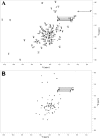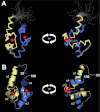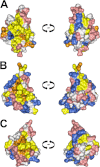Solution NMR structure of the Ca2+-bound N-terminal domain of CaBP7: a regulator of golgi trafficking
- PMID: 22989873
- PMCID: PMC3488092
- DOI: 10.1074/jbc.M112.402289
Solution NMR structure of the Ca2+-bound N-terminal domain of CaBP7: a regulator of golgi trafficking
Abstract
Calcium-binding protein 7 (CaBP7) is a member of the calmodulin (CaM) superfamily that harbors two high affinity EF-hand motifs and a C-terminal transmembrane domain. CaBP7 has been previously shown to interact with and modulate phosphatidylinositol 4-kinase III-β (PI4KIIIβ) activity in in vitro assays and affects vesicle transport in neurons when overexpressed. Here we show that the N-terminal domain (NTD) of CaBP7 is sufficient to mediate the interaction of CaBP7 with PI4KIIIβ. CaBP7 NTD encompasses the two high affinity Ca(2+) binding sites, and structural characterization through multiangle light scattering, circular dichroism, and NMR reveals unique properties for this domain. CaBP7 NTD binds specifically to Ca(2+) but not Mg(2+) and undergoes significant conformational changes in both secondary and tertiary structure upon Ca(2+) binding. The Ca(2+)-bound form of CaBP7 NTD is monomeric and exhibits an open conformation similar to that of CaM. Ca(2+)-bound CaBP7 NTD has a solvent-exposed hydrophobic surface that is more expansive than observed in CaM or CaBP1. Within this hydrophobic pocket, there is a significant reduction in the number of methionine residues that are conserved in CaM and CaBP1 and shown to be important for target recognition. In CaBP7 NTD, these residues are replaced with isoleucine and leucine residues with branched side chains that are intrinsically more rigid than the flexible methionine side chain. We propose that these differences in surface hydrophobicity, charge, and methionine content may be important in determining highly specific interactions of CaBP7 with target proteins, such as PI4KIIIβ.
Figures









Similar articles
-
Structural insights into Ca2+-dependent regulation of inositol 1,4,5-trisphosphate receptors by CaBP1.J Biol Chem. 2009 Jan 23;284(4):2472-81. doi: 10.1074/jbc.M806513200. Epub 2008 Nov 13. J Biol Chem. 2009. PMID: 19008222 Free PMC article.
-
NMR derived solution structure of an EF-hand calcium-binding protein from Entamoeba Histolytica.Biochemistry. 2001 Dec 4;40(48):14392-403. doi: 10.1021/bi0114978. Biochemistry. 2001. PMID: 11724551
-
Nuclear magnetic resonance structure of calcium-binding protein 1 in a Ca(2+) -bound closed state: implications for target recognition.Protein Sci. 2011 Aug;20(8):1356-66. doi: 10.1002/pro.662. Epub 2011 Jun 17. Protein Sci. 2011. PMID: 21608059 Free PMC article.
-
Molecular mechanisms of calmodulin's functional versatility.Biochem Cell Biol. 1998;76(2-3):313-23. doi: 10.1139/bcb-76-2-3-313. Biochem Cell Biol. 1998. PMID: 9923700 Review.
-
A Non-Canonical Calmodulin Target Motif Comprising a Polybasic Region and Lipidated Terminal Residue Regulates Localization.Int J Mol Sci. 2020 Apr 15;21(8):2751. doi: 10.3390/ijms21082751. Int J Mol Sci. 2020. PMID: 32326637 Free PMC article. Review.
Cited by
-
Structure-Function Diversity of Calcium-Binding Proteins (CaBPs): Key Roles in Cell Signalling and Disease.Cells. 2025 Jan 21;14(3):152. doi: 10.3390/cells14030152. Cells. 2025. PMID: 39936944 Free PMC article. Review.
-
Sense and specificity in neuronal calcium signalling.Biochim Biophys Acta. 2015 Sep;1853(9):1921-32. doi: 10.1016/j.bbamcr.2014.10.029. Epub 2014 Nov 4. Biochim Biophys Acta. 2015. PMID: 25447549 Free PMC article. Review.
-
The key target of neuroprotection after the onset of ischemic stroke: secretory pathway Ca(2+)-ATPase 1.Neural Regen Res. 2015 Aug;10(8):1271-8. doi: 10.4103/1673-5374.162760. Neural Regen Res. 2015. PMID: 26487855 Free PMC article.
-
Modulation of phosphatidylinositol 4-phosphate levels by CaBP7 controls cytokinesis in mammalian cells.Mol Biol Cell. 2015 Apr 15;26(8):1428-39. doi: 10.1091/mbc.E14-07-1243. Epub 2015 Feb 25. Mol Biol Cell. 2015. PMID: 25717182 Free PMC article.
-
Calcium Sensors in Neuronal Function and Dysfunction.Cold Spring Harb Perspect Biol. 2019 May 1;11(5):a035154. doi: 10.1101/cshperspect.a035154. Cold Spring Harb Perspect Biol. 2019. PMID: 30833454 Free PMC article. Review.
References
-
- Seidenbecher C. I., Langnaese K., Sanmartí-Vila L., Boeckers T. M., Smalla K. H., Sabel B. A., Garner C. C., Gundelfinger E. D., Kreutz M. R. (1998) Caldendrin, a novel neuronal calcium-binding protein confined to the somato-dendritic compartment. J. Biol. Chem. 273, 21324–21331 - PubMed
-
- Wu Y. Q., Lin X., Liu C. M., Jamrich M., Shaffer L. G. (2001) Identification of a human brain-specific gene, calneuron 1, a new member of the calmodulin superfamily. Mol. Genet. Metab. 72, 343–350 - PubMed
-
- Mikhaylova M., Sharma Y., Reissner C., Nagel F., Aravind P., Rajini B., Smalla K. H., Gundelfinger E. D., Kreutz M. R. (2006) Neuronal Ca2+ signaling via caldendrin and calneurons. Biochim. Biophys. Acta 1763, 1229–1237 - PubMed
Publication types
MeSH terms
Substances
Grants and funding
LinkOut - more resources
Full Text Sources
Molecular Biology Databases
Miscellaneous

